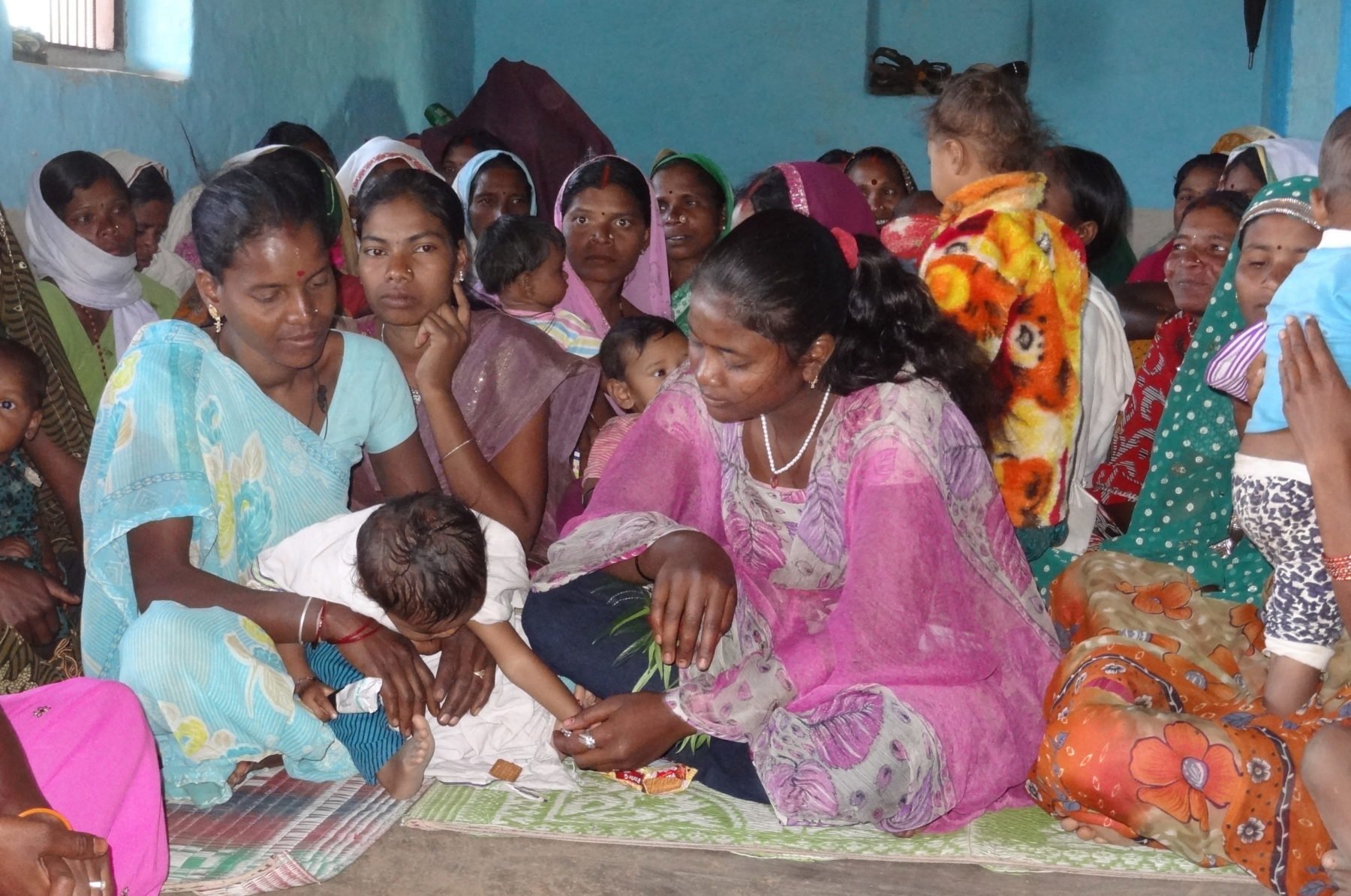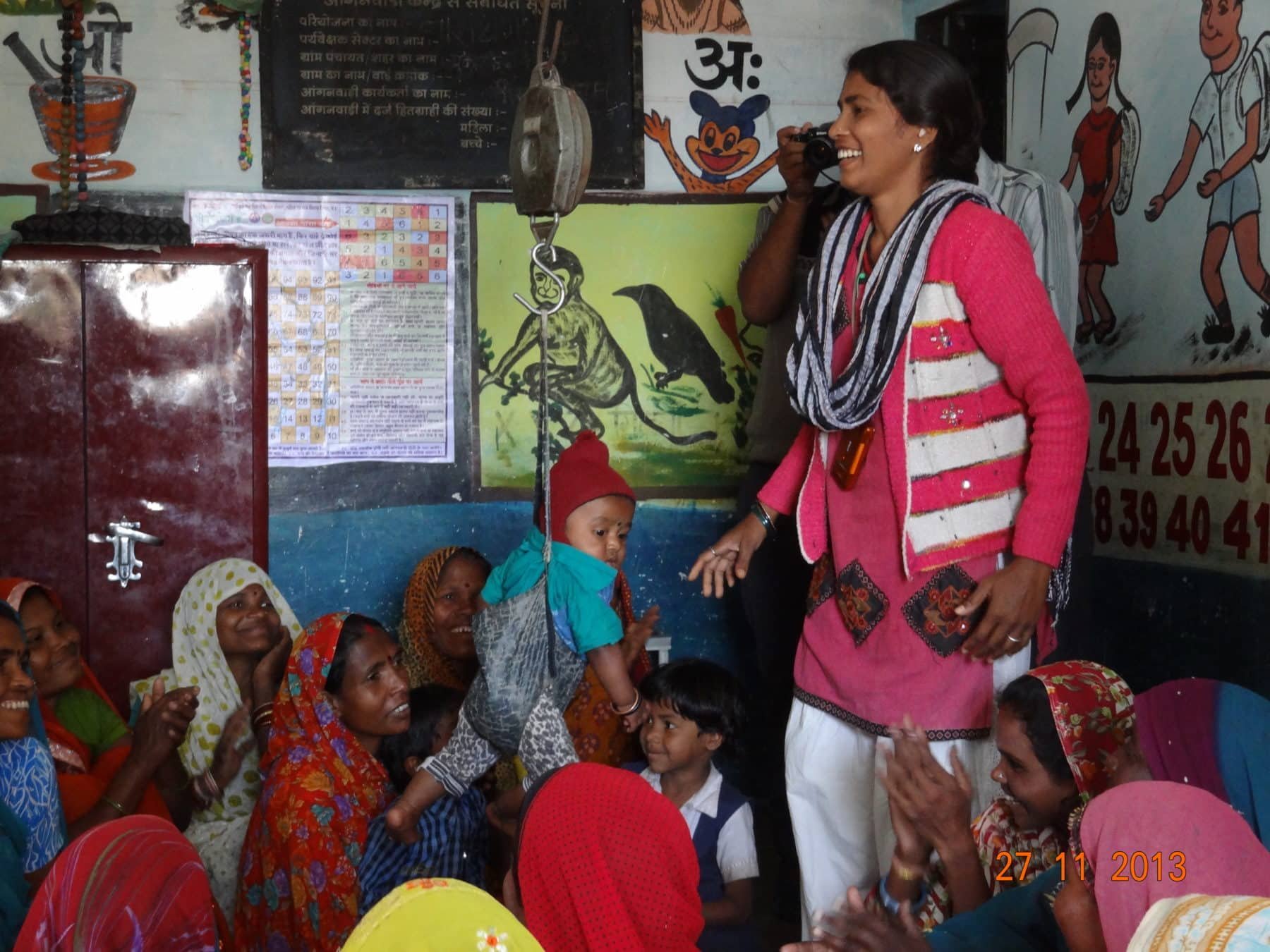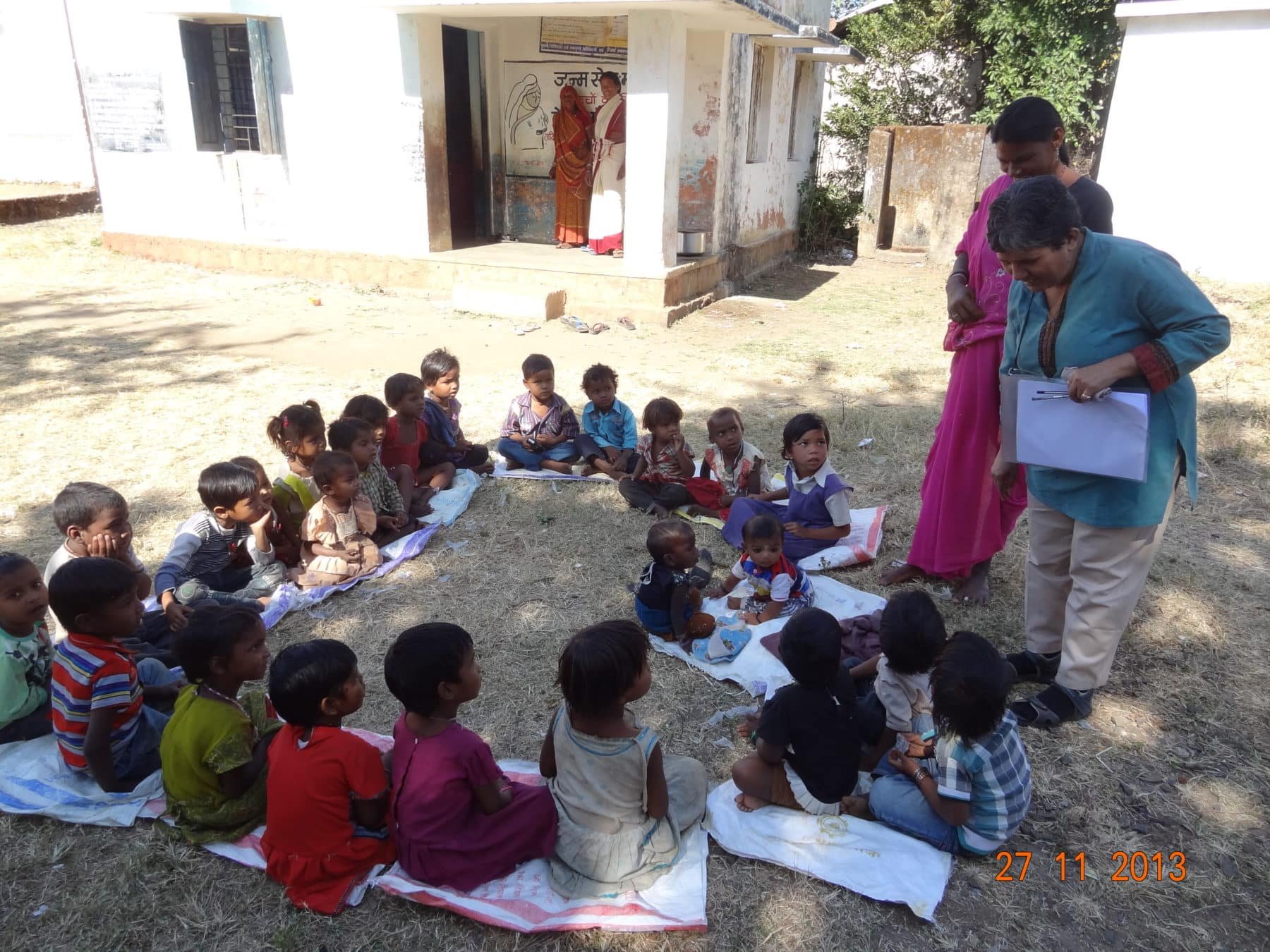Project: Nutrition, Education, and Watershed Development
Location: Villages in Pushprajgarh Block, Anuppur District, Madhya Pradesh
Category: Education and Health Care
Educated Mothers, Healthier Children
Once again this year, IDS supported the Watershed Organisation Trust (WOTR) nutrition and education project. The goal of the project is to lower the incidence of stunting and wasting among children between 0 and 5 years of age caused by the illiteracy of their mothers. The project is ongoing in 11 villages.
The IDS grant money was used to pay for growth monitoring units/weighing machines, growth monitoring cards, training on health and nutrition management, and project coordination and management.
The tribal population in these villages is entitled to government schemes, but very few families take advantage of them. The reason for this is primarily the illiteracy of the mothers, who do not realize they can regularly visit the anganwadi (government-funded childcare center at the village level) to get mineral supplements provided under the Integrated Child Development Scheme (ICDS).
WOTR has put its efforts into motivating anganwadi workers to keep in touch with the mothers of children under 5 so that the government benefits and schemes reach both the mothers and their children. WOTR holds monthly SHG (self-help group) and growth monitoring meetings at the anganwadi, making sure the sevikas (women who play the role of social workers in the village) are involved. It’s vital that the sevikas stay informed about the objectives of WOTR’s project so that it can be run parallel with the ICDS. In that way, both projects can have maximum participation by the mothers who are entitled to the benefits.
Each month, children are weighed at anganwadis, and sevikas provide information about the children’s current status to their mothers. In addition, sevikas conduct SHG meetings and door-to-door encounters with those who are not SHG members. The goal is to motivate the mothers to attend meetings and to bring their children in regularly for weighing.
Six SHGs were formed in 2017 in the project villages. WOTR conducted regular meetings with the sevikas at which the status of children in the village was discussed. Based on the child monitoring that is taking place for 695 children, the percentage of children who are “normal” increased from 18% to 26% between October 2016 and June 2017. Malnourishment among second graders has decreased from 30% last year to 23% this year.
IDS Coordinator: Ron Fernandes
Project Manager: Sundar Bhagwat
–2016 IDS annual report
IDS’s 2016 grant to the Watershed Organisation Trust (WOTR) nutrition and education project provided education to mothers of children in the critical age group of 0–5 years in eleven tribal villages—Ataria, Karan Pathar, Ranai Kapa, Piparia, Kusera, Koliha Tola, Lila Tola, Manpur, Padri Khar, Vicharpur, and Beldongri in Block Pushprajgarh of District Anuppur (Madhya Pradesh). A government-funded watershed development project in these villages complemented and sustained the work of the nutrition and education project.
Since project initiation, WOTR has conducted the following activities:
Training of village para-workers (Wasundhara sevikas): More than twenty village youth have been trained by WOTR to monitor child health and nutrition, including the use of software to monitor the child growth process. The participants visited the village anganwadi (government-funded childcare center at the village level) for practical demonstrations of weighing and display of individual status cards for each child. All participants prepared a follow-up action plan for their own village.

Child growth monitoring: Since September 2016, WOTR monitored the growth of 615 children (306 girls and 309 boys) every month in the project area. The data is maintained by both the anganwadi and the WOTR staff. Malnourished children are provided multivitamin packets every month by the anganwadi.

Child growth monitoring with mothers: WOTR participates in regular anganwadi meetings on child growth monitoring, weighing of children, and comparison of weights with the previous month. The linkage with anganwadis has been strengthened; government health workers at the anganwadis now understand WOTR’s child growth monitoring formats and have begun sharing their data.
Health and hygiene education at schools: WOTR staff conducted sessions on health and hygiene in all the anganwadis. As part of the project, WOTR also taught these concepts to primary and middle school children from these villages.
Watershed Development
In July, 2013, WOTR was selected to implement the Pradhan Mantri Krishi Sinchayee Yojana (PMKSY) Watershed Development Project in these project villages. This project is supported by the government of India. The core objectives of the program are:
Watershed Treatments: The goal is to limit soil erosion at the time of heavy rains and to ensure the availability of rain water during the dry months by storing it in ponds. Check dams are constructed by the village watershed committees with the technical support of WOTR and the financial support of the Indian government.
Sustainable Agriculture and Livelihoods: Vlilagers’ only asset is their agricultural land. To enhance land productivity, WOTR is introducing sustainable organic practices in which good quality seeds (as well as vermi-composting structures and irrigation tools) are provided to interested farmers. Individuals and self-help groups are given small funds to secure their livelihoods.
WOTR’s implementation of the watershed project in these villages ensures synergies for the sustainability of the IDS-funded nutrition and education project by leveraging existing WOTR resources, including social networks and local governance institutions. Enhancing the livelihoods of the villagers enables them to invest more in the health of their children. It also enables more reliable tracking of outcomes for children of villagers who had migrated to cities to seek better economic opportunities. IDS funding enables WOTR to act as a crucial intermediary to resolve the “last mile” problem—where government funds for development do not reach their intended beneficiaries at the grass roots. WOTR’s expertise, experience, and reputation in collaborating with government agencies over the past 25 years enables this NGO to understand and work closely with these agencies to resolve this problem.
IDS Coordinator: Ron Fernandes
Project Manager: Harish Daware
–2016 IDS annual report
According to the United Nations Children’s Fund (UNICEF), one in every three malnourished children in the world lives in India. Statistics show that 43% of children in India between the ages of 0–5 years are underweight and 59% are stunted. Many die of malnourishment.
A poor diet is just one factor that can contribute to malnutrition in children; other factors include access to health services, quality of care for the child and pregnant mother, and hygiene practices. Girls are more at risk than boys because of their lower social status. The prevalence of malnourishment and undernourishment is far higher in tribal areas than in cities. The first five years in a child’s life are critical in solving the problems of malnourishment.
The IDS intervention, in partnership with Watershed Organisation Trust, Inc. (WOTR), has the following key elements:
- Training mothers with children in the age group of 0–5 years to assess the growth of their children and educating mothers on their children’s food, health, and nutritional needs.
- Leveraging the resources of anganwadis (courtyard shelters) initiated by the government of India in 1975. WOTR organizes and trains the poor, especially women, to effectively utilize anganwadi resources to ensure their children’s health.
- Intervening in the village ecosystems (watersheds) by building rainwater harvesting systems to enhance livelihoods and provide sustainable incomes to the villages. This watershed intervention, in turn, enables villagers to provide more nutritious foods and better health care for their children. It also decreases the rate of migration out of the villages, allowing for children’s health to be more systematically monitored during their preschool years.

The reduction in malnutrition among children in the six villages over the project period was monitored using WHO Child Growth Standards. The monitoring used “weight-for-age” as an indicator of nutritional status of children in the age group 0–5 years. Weight-for-age reflects body mass relative to chronological age with low weight-for-age implying that the child is undernourished.
During each quarterly monitoring period from July 2013 to July 2015, the children were classified in one of four grades: Grade III – Severe Malnourishment, Grade II – Moderate Malnourishment, Grade I – Mild Malnourishment, and Normal.
Over the project period, the percentage of girls:
- in Grade III decreased from 10% to 9%
- in Grade II decreased from 32% to 16%
- in Grade I increased from 27% to 36%
- in the Normal category increased from 24% to 33%.

Over the project period, Rs. 909,586 was expended; 274 children benefitted, which comes to Rs. 1,100 ($17) per child per year. Children’s growth is now regularly monitored and their mothers are aware of their health and hygiene issues. This intervention will also benefit families’ subsequent children, as the mothers are now more knowledgeable about how to raise healthy children and monitor their health. In this way, the positive effects of the project will be sustained beyond the project period.
Through this project, we discovered the importance of social networking as well as the participatory efforts of community and local village institutions for successful project outcomes. Growth monitoring and education interventions are now reaching 274 children out of a total of 429 children in these six villages. The challenge is to reach the remaining children, and we plan to use social networks in these villages, as well as social pressure, to encourage other mothers to enroll their children in growth monitoring.
We also learned that concurrent investments in ecosystem interventions are central to successful outcomes. Our efforts to conserve soil and water in these villages are resulting in improved agricultural production and water availability—leading to increases in socio-economic status. This also results in lower migration in and out of villages, making more accurate monitoring of infant growth and health status possible.
Educating mothers in the importance of healthy nutrition in preschool children and empowering them to improve their children’s health are critical. Overall improved nutrition in preschool children able to reach target growth curves leads to sustained primary school attendance and better educational outcomes as well.
–2015 IDS annual report
Nutrition and Education for the Critical Age Group (0–5 Years)
According to the United Nations Children’s Fund (UNICEF):
–Child malnutrition is more common in India than in sub-Saharan Africa. One in every three malnourished children in the world lives in India.
–The prevalence of malnutrition varies across states, with Madhya Pradesh recording the highest rate (55%) and Kerala among the lowest (27%).
–Malnutrition in children is not measured by food intake alone; it is also influenced by access to health services, quality of care for the child and pregnant mother, and good hygiene practices. Girls are more at risk than boys because of their lower social status.
The goals of this intervention (funded again this year by IDS) are threefold:
First, we will train mothers with children in the age group of 0–5 years to assess their children’s growth; we will also educate the mothers on food, health, and nutritional needs.
Second, we want to leverage the resources of anganwadis (courtyard shelters) initiated by the Indian government in 1975. Anganwadis are funded through the Integrated Child Development Services (ICDS) program to address child hunger and malnutrition. Unfortunately, as with many government schemes in India, the anganwadi system is underfunded and poorly managed. Watershed Organization Trust, Inc. (WOTR) organizes and trains the poor, especially women, to effectively utilize anganwadi resources to ensure their children’s health; this is done by training the mothers and the anganwadi workers and by building local institutions.
Third, we adopt a holistic approach by intervening in the village ecosystems (watersheds) and building rainwater harvesting systems; these enhance the livelihoods of villagers and provide sustainable incomes to the villages. This, in turn, enables villagers to provide more nutritious foods and better health care for their children.
We have discovered the importance of social networking for successful project outcomes. Growth monitoring and education interventions are now reaching 295 children out of a total of 429 children in these five villages. The challenge is to reach the remaining children, and we plan to use social networks in these villages, as well as social pressure, to encourage other mothers to enroll their children in growth monitoring. The cost per child per year is 820 rupees ($14).
We have also learned that concurrent investments in ecosystem interventions (such as the rainwater harvesting systems) are central to successful outcomes. Our efforts to conserve soil and water in these villages are resulting in improved agricultural production and water availability—leading to increases in socio-economic status. Empowering mothers by teaching the importance of healthy nutrition in preschool children proved to be a key component. Overall, our efforts have resulted in improved nutrition in preschool children, enabling them to reach target growth curves that in turn lead to improved and sustained school attendance.
–2014 IDS annual report
The Watershed Organization Trust (WOTR) is the largest nonprofit organization working on sustainable rehabilitation of ecosystems in rural India. WOTR promotes watershed development and rainwater harvesting to ensure the sustainability of village ecosystems; it also implements projects using community participation to improve the lives of people living on watersheds.
With IDS financial support, WOTR educates people about the importance of a balanced diet and essential nutrition for healthy children living in a village on a watershed. It trains mothers with children in the age group of 0–5 years to assess the growth of their children and provides them with background information on children’s food, health, and nutritional needs. It also aims to leverage the resources of anganwadis (courtyard shelters) initiated by the Indian government in 1975.
Every month, a worker visits each village anganwadi to monitor the growth of village children 0–5 years old. A total of 273 children are monitored every month out of the total of 429 children in five villages.
Because of ongoing watershed development activities in these villages, WOTR will also involve panchayat (village council) members in monthly meetings to inform them about the project activities. The goal is to leverage the resources provided by the government for nutrition of children, ensuring that those funds are put to their appropriate use.
As a part of the project, WOTR works with children in middle schools to educate them on health, water, and sanitation concerns. WOTR promoters visit schools and conduct pappu ka pitara and gol-gol dhani, activities that consist of educational tools on health and sanitation, such as sanitation hero, a snake and ladder game about personal hygiene, and a game about bringing safe and clean drinking water to a village.
Concurrently, WOTR is implementing a project on watershed development and rainwater harvesting in these five villages. The goal of this project is to enlist community participation to conserve soil and water so that agricultural production, water availability, and socio-economic status can increase.
–2013 IDS annual report

